NCERT Solutions are considered one of the best study materials while preparing for the CBSE Class 12 Economics Board examinations. This study resource gives a deep insight into the subject as NCERT Solutions has been collated by our subject-matter experts who have vast knowledge and experience in their specialised field.
Download PDF of NCERT Solutions For Class 12 Macroeconomics Chapter 6 – Open Economy Macroeconomics
Access NCERT Solutions for Class 12 Macroeconomics Chapter 6
NCERT Macroeconomics Solutions Class 12 Chapter 6
1. Differentiate between balance of trade and current account balance.
| Basis of Comparison | Balance of trade | Current account balance |
| Definition | The difference between the import and export of all goods | The difference between the import and export of goods as well as services |
| Transaction type | Transactions of visible items, i.e., goods, take place | Transactions of visible items (goods) and invisible items (services) take place |
| Scope | It is a narrow concept and forms a part of the current account balance | It is a wider concept that comprises the balance of trade |
2. What are official reserve transactions? Explain their importance in the balance of payments.
Transactions that are carried out by the monetary authority of a country which makes changes in official reserves is known as official reserve transaction or ORT. These transactions include the purchase and sale of currency in the exchange market for other assets and foreign currencies. By selling foreign currencies in the exchange market during periods of deficit and purchasing them during surplus periods. The increase and decrease in the official reserve are called the balance of payments surplus and deficit, respectively.
The importance of official reserve transactions in balance of payments are the following:
1. They help in adjusting deficit or surplus in the balance of payments
2. Purchasing of own currency is regarded credit item in the balance of payments, whereas selling is regarded as a debit.
3. Distinguish between the nominal exchange rate and the real exchange rate. If you were to decide whether to buy domestic goods or foreign goods, which rate would be more relevant? Explain.
The nominal exchange rate is defined as the relative price of two currencies. It means how many units of domestic currency need to be utilised to purchase a unit of foreign currency and vice versa. The real exchange rate measures how much quantity of goods can be purchased with domestic currency for a similar price in terms of foreign currency. It measures foreign prices with respect to domestic prices, or it can be said as the ratio of foreign prices to domestic prices. For e.g., if 1 kg of rice can be purchased with 4 USD, then how much rice can be purchased in India considering the price of rice in India is Rs. 20 per kg?
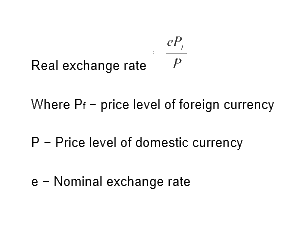
Real exchange rate is more relevant in cases of buying domestic and foreign goods
4. Suppose it takes 1.25 yen to buy a rupee, and the price level in Japan is 3 and the price level in India is 1.2. Calculate the real exchange rate between India and Japan (the price of Japanese goods in terms of Indian goods). (Hint: First find out the nominal exchange rate as a price of yen in rupees).
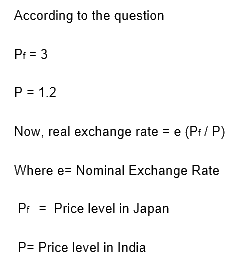
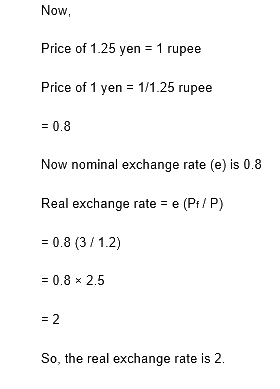
5. Explain the automatic mechanism by which BoP equilibrium was achieved under the gold standard.
In the Gold standard system, gold is considered a common unit to measure another nation’s currency in other words value of a currency was defined in terms of gold. The exchange rates were fixed in upper and lower limits, and it was allowed to fluctuate within those limits. Therefore, exchange rates became stable under the gold standard, and due to this reason, all countries maintained their individual stock of gold which was used for currency exchange.
6. How is the exchange rate determined under a flexible exchange rate regime?
In a flexible exchange rate regime, the rate of exchange is determined on the basis of demand and supply. The equilibrium is attained when demand and supply are equal to each other.
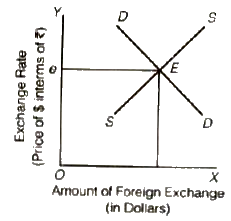
In this figure, X-axis represents demand for foreign currency while the Y-axis represents exchange rates. Demand curve DD is sloping downward, which shows the inverse relationship between the rate of exchange and demand for foreign currency. The supply curve SS is upward sloping which shows the positive development of the rate of exchange and supply of foreign currency. E is the point where the equilibrium exchange rate is reached.
7. Differentiate between devaluation and depreciation.
| Devaluation | Depreciation |
| Devaluation is when the currency exchange rate is officially lowered by the government in comparison to another country’s exchange rate. | Currency depreciation occurs by forces of demand and supply in the global market instead of government |
| Devaluation occurs by lowering the fixed exchange rate in the international market | Depreciation occurs on a floating exchange rate. |
| There is no fixed time for devaluating currency | It occurs every day in global markets |
8. Would the central bank need to intervene in a managed floating system? Explain why.
A managed floating system is a system where exchange rates fluctuate on a day-to-day basis. The role of a central bank in such a system is to maintain balance by purchasing of foreign exchange when the floating rate is low in order to raise its rate and similarly selling foreign exchanges when the floating rate is high in order to bring the rate down.
9. Are the concepts of demand for domestic goods and domestic demand for goods the same?
No, both concepts are not the same as demand for domestic goods means demand for goods that are produced domestically in both domestic and international markets, whereas domestic demand for goods means domestic demand for goods that are produced domestically or internationally. Demand for domestic goods is a broader concept that includes domestic demand for goods.
10. What is the marginal propensity to import when M = 60 + 0.06Y? What is the relationship between the marginal propensity to import and the aggregate demand function?
Marginal propensity to import is the change in import values which is brought about by additional income of the country. It is the extent to which a country’s import increases/decreases in relation to the change in GDP.
Here we see that M = 60 + 0.06Y
Now, m = 0.06 (Marginal propensity to import)
Aggregate demand function is negatively affected by the marginal propensity to import. Therefore, with increasing income, there is a decrease in aggregate demand as additional income is spent on importing foreign products.
11. Why is the open economy autonomous expenditure multiplier smaller than the closed economy one?
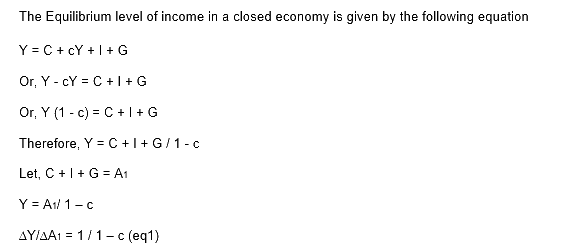
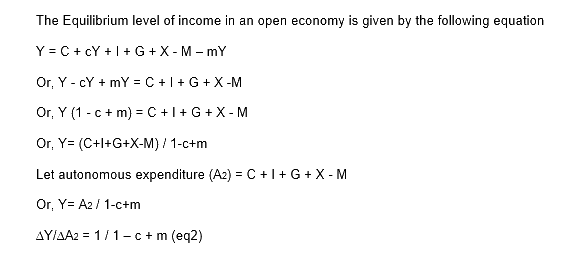
On comparing the two equations and the denominators of the two multipliers, it can be concluded that multiplier in an open economy is smaller than the closed economy as denominator of open economy is greater than the closed economy.
12. Calculate the open economy multiplier with proportional taxes, T = tY, instead of lump−sum taxes as assumed in the text.
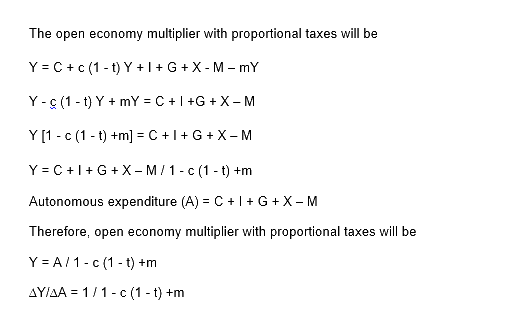
13. Suppose C = 40 + 0.8Y D. T = 50, I = 60, G = 40, X = 90, M = 50 + 0.05Y
(a) Find equilibrium income
(b) Find the net export balance at equilibrium income
(c) What happens to equilibrium income and the net export balance when the government purchases increase from 40 to 50?
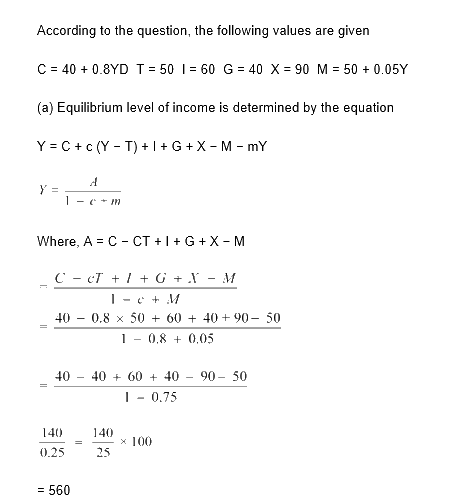
Therefore, equilibrium income is Rs. 560
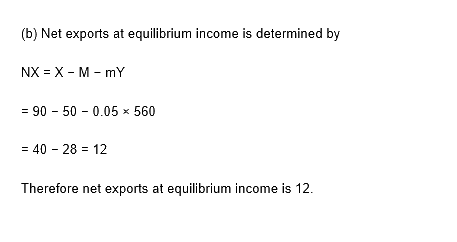
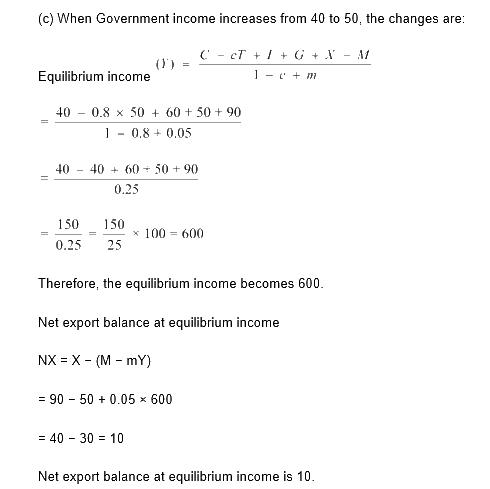
14. In the above example, if exports change to X = 100, find the change in equilibrium income and the net export balance.
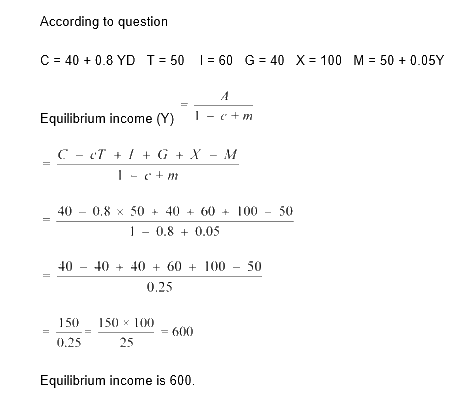

15. Explain why G − T = (Sg − I) − (X − M).
Savings and income are equal at equilibrium level in an economy while in an open economy savings and investments are different.
Y = C + I + G + X – M
NX = NX = X – M
Y = C + I + G + NX
Y – C – G = I + NX (eq.1)
Y – C – G can be regarded as national savings (S) or the net national income which is obtained after all consumption and government spending.
Therefore, it can be written that
Y – C – G = S
Or, S = I + NX
S = Private Savings (Sp) + Government Savings (Sg)
Now
S = Sp + Sg
Sp + Sg = I + NX (as S = I + NX)
NX = Sp + Sg – I (eq.2)
We know,
Sp = Y – C – T
Sg = T – G
Putting the values in eq.2 we get
NX = Y – C – T + T – G – I
NX = Y – C – G – I
G = Y – C – I – NX
Now subtracting T from both sides
G – T = Y – C – I – NX – T
G – T = Y – C – T – I – NX
G – T = (Sp– I) – NX
Where, NX = X – M
G – T = (SP– I) – (X – M)
16. If inflation is higher in country A than in Country B, and the exchange rate between the two countries is fixed, what is likely to happen to the trade balance between the two countries?
Exchange rate plays an important role in the level of trade taking place in a country. In this question we see that country A is having a higher inflation than B. As exchange rate is fixed in this context it will be beneficial for the country A to import goods from country B and for B to export goods to country A. Therefore, country A will be experiencing trade deficit as import is more than export and similarly country B will experience trade surplus as there is more export and comparatively less imports.
17. Should a current account deficit be a cause for alarm? Explain.
An excess of import of goods, services and transfers over total exports of goods, services and transfers is called as current account deficit. This situation makes a country debtor to all other nations of the world. But this generally cannot be considered an alarming situation because countries can be having deficits which is used for increasing productivity and exports in future.
18. Suppose C = 100 + 0.75Y D, I = 500, G = 750, taxes are 20 per cent of income, X = 150, M = 100 + 0.2Y. Calculate equilibrium income, the budget deficit or surplus and the trade deficit or surplus.
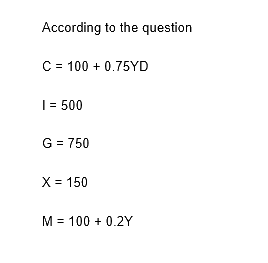

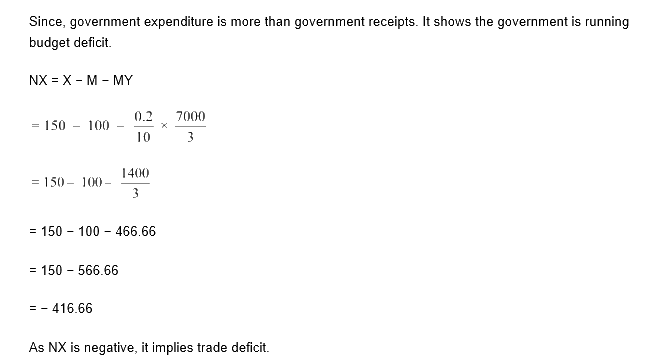
19. Discuss some of the exchange rate arrangements that countries have entered into to bring about stability in their external accounts.
The following exchange rate arrangements helped bring stability to external accounts:
1. Crawling peg is a system of continuous and regular adjustments that allows a variation of 1% at any given time.
2. Under the system of wider bands, adjustments are allowed in fixed exchange rates. A variation of 10% is applied between the currencies of any two countries. A country can depreciate its currency to improve the Balance of payments. It will lead to an increase in demand for domestic goods as the purchasing power of other currencies increases which results in more exports.
3. The third type is called managed floating, where the government has the authority to make changes in the exchange rate as per situation. The variation is not limited, unlike the previous two measures.
NCERT Solution for Class 12 Economics Chapter 6 – Open Economy Macroeconomics. This chapter explains, in brief, a manner about how the open economy macroeconomics functions.
Chief concepts of this chapter –
- Open economy
- Balance of payment
- Current account
- Capital account
- Balance of trade
- Autonomous transaction
Conclusion
NCERT Solutions for Class 12 Economics Chapter 6 provides a broad range of illustrative examples, which helps the students to comprehend and learn quickly. The above-mentioned are the illustrations for the Class 12 CBSE syllabus. For more solutions and study materials of NCERT solutions for Class 12 Economics, visit BYJU’S or download the app for more information.
Also, explore –














Comments